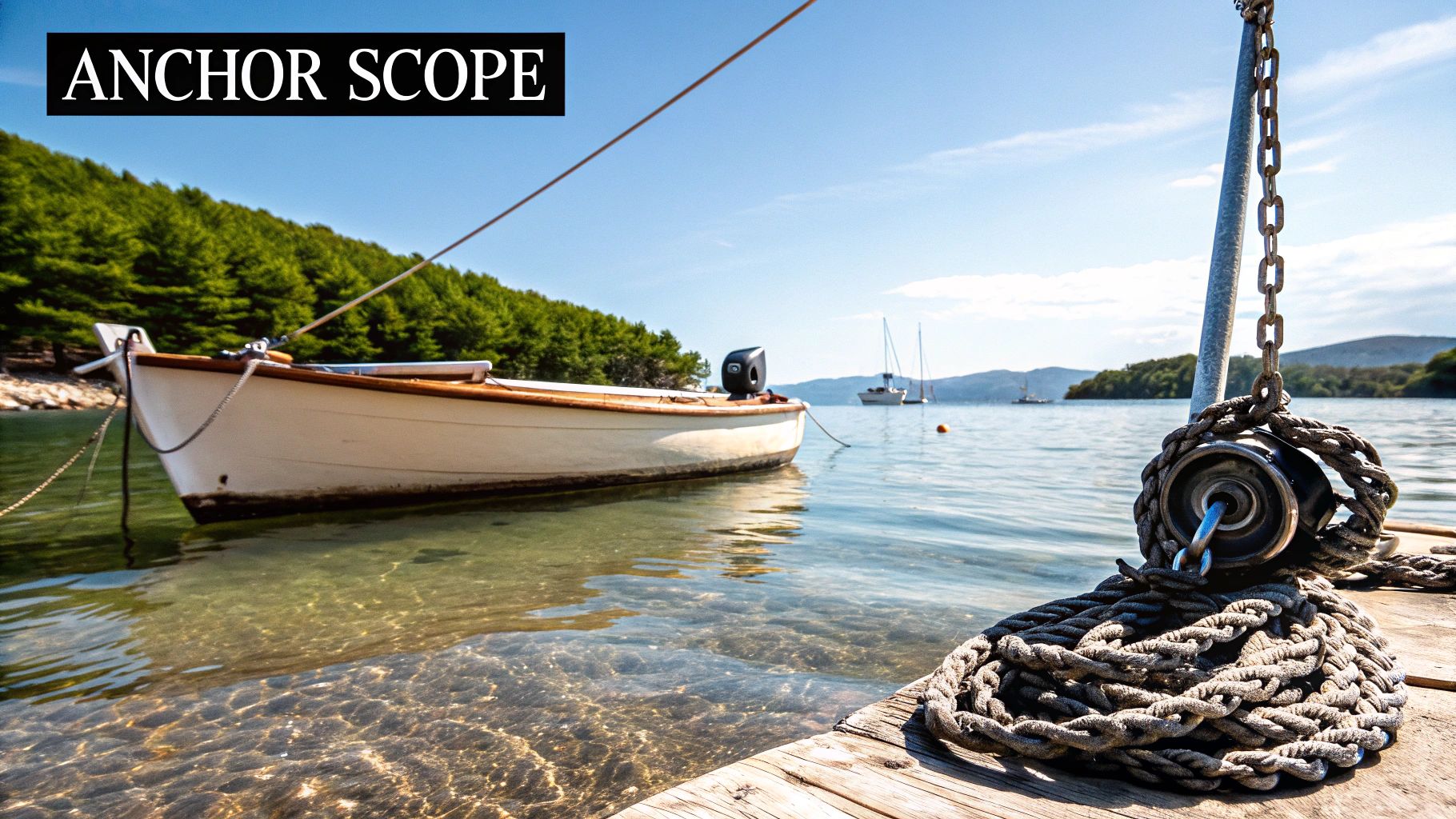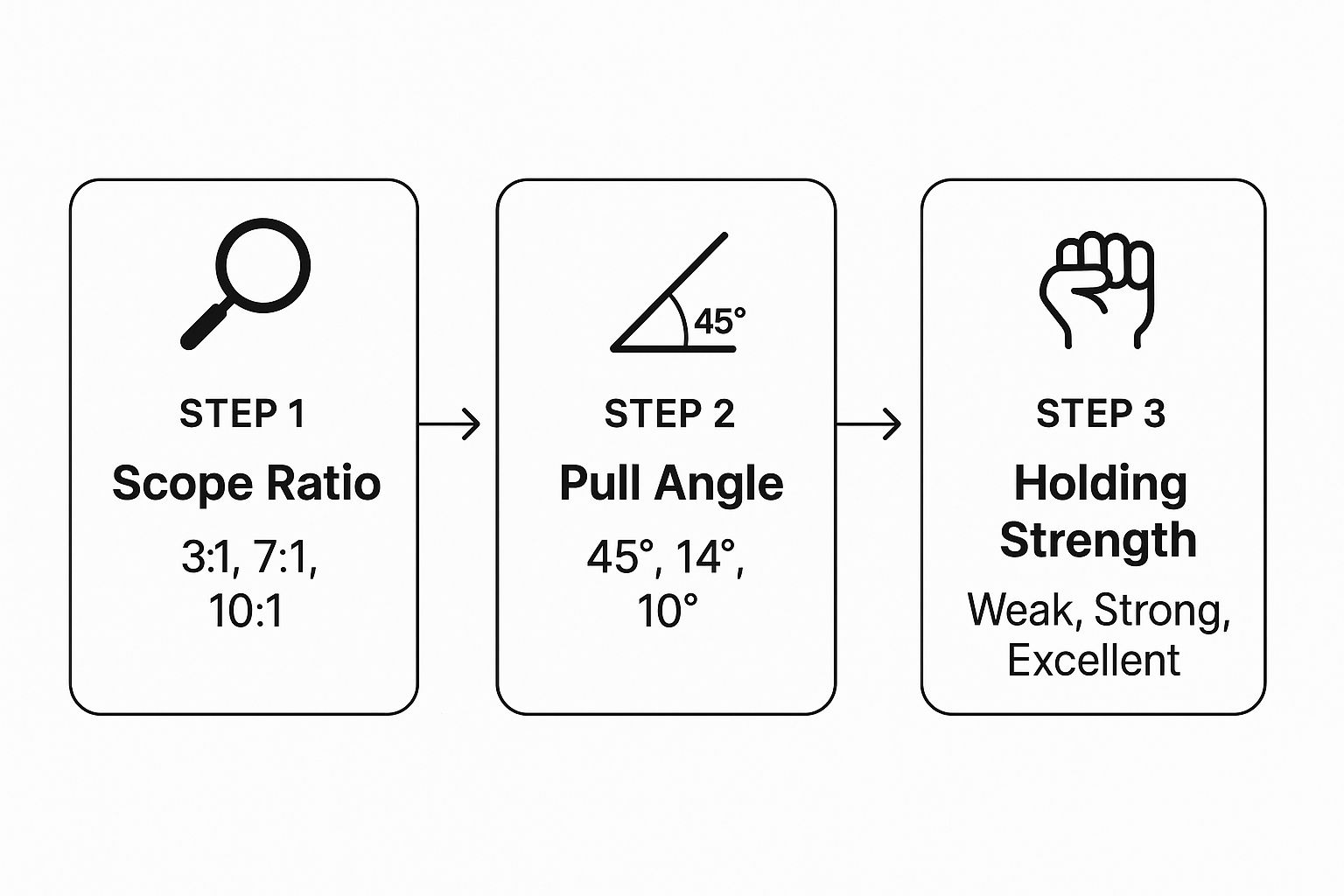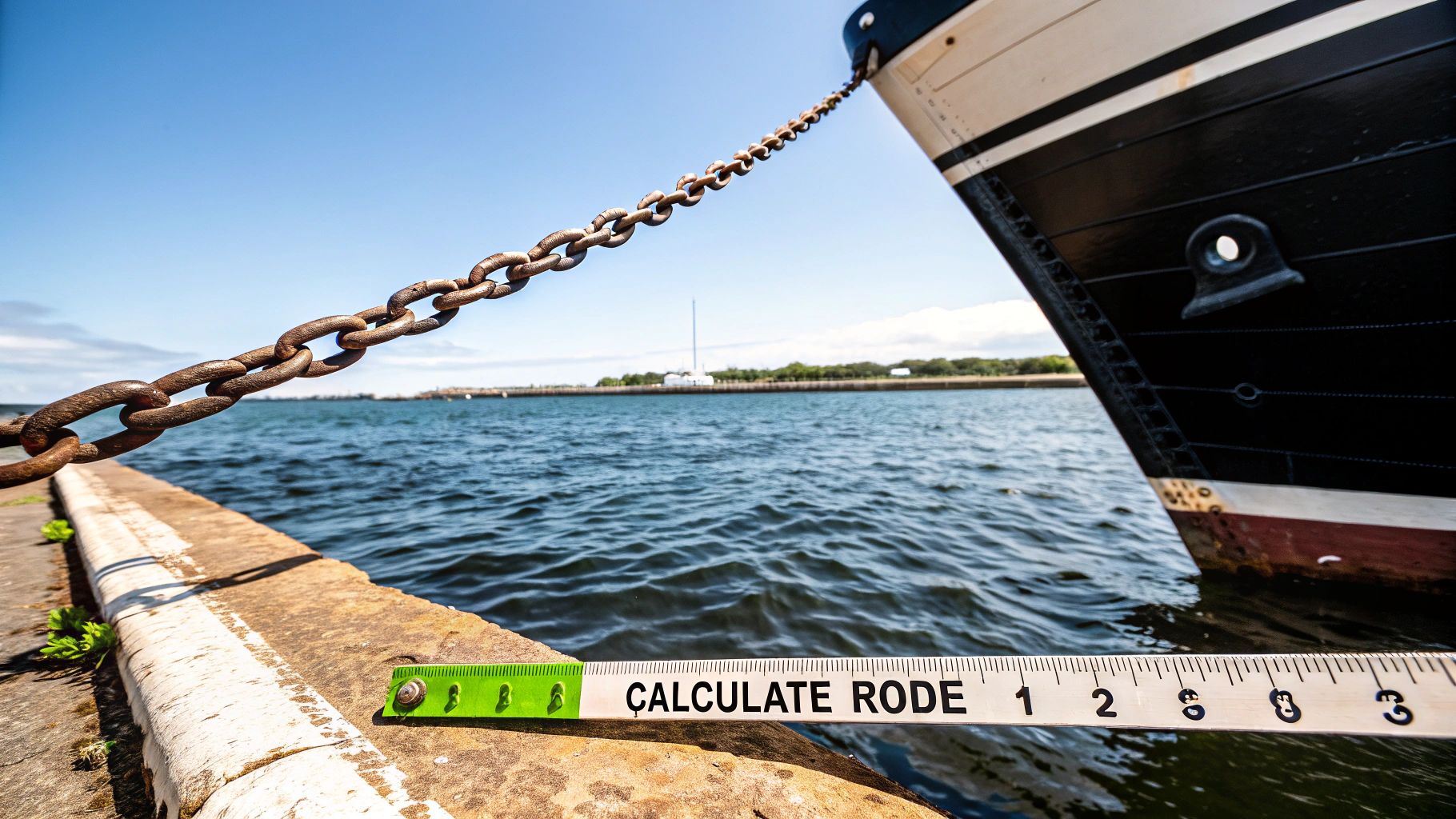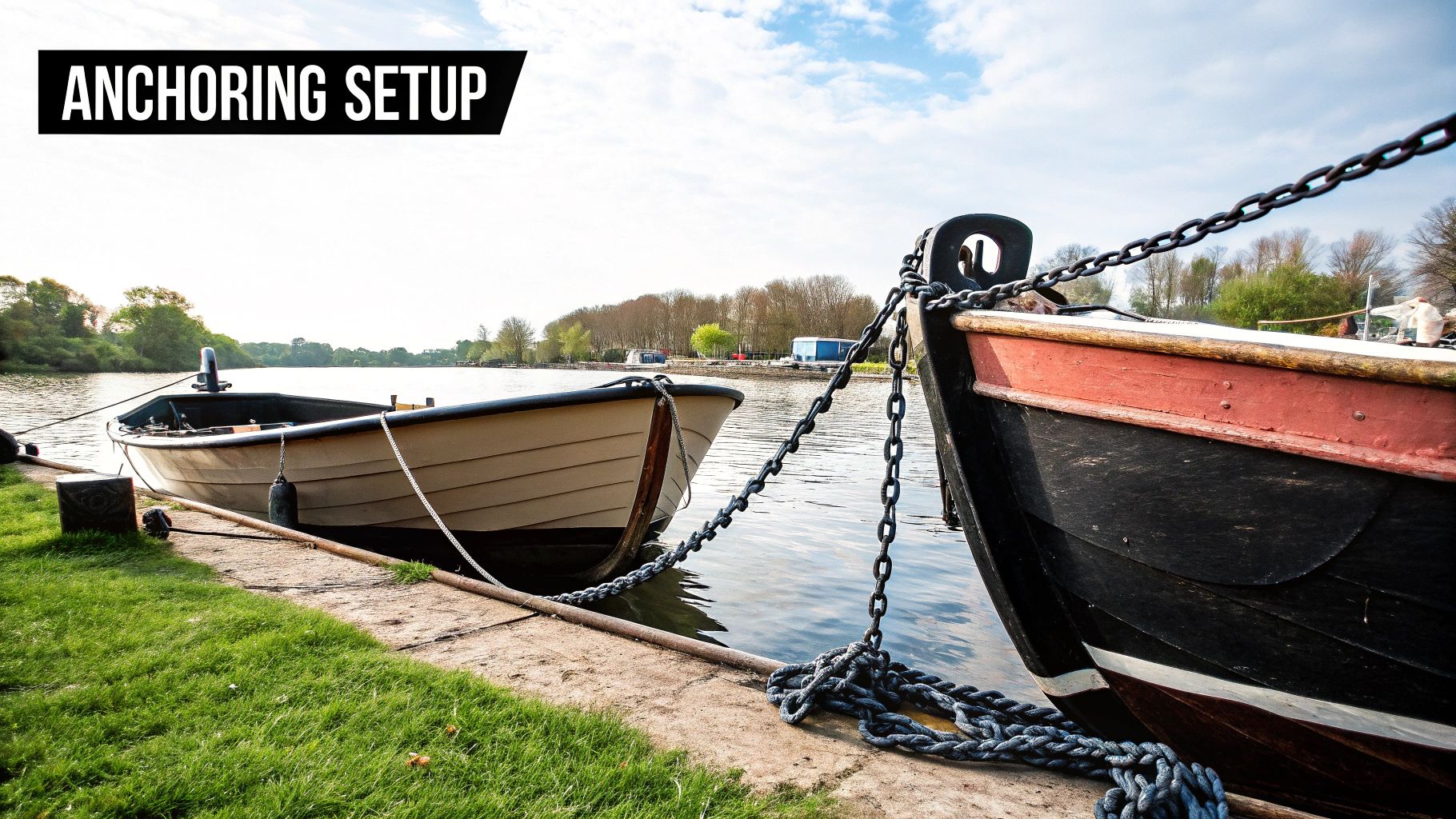How Much Anchor Chain Do I Need? A Boater's Guide
For most boaters, the rule of thumb you'll hear over and over is an anchor scope of 7:1 for calm weather and bumping that up to 10:1 for stormy conditions.
What's scope? It's simply the ratio of your anchor rode (the chain or rope you let out) to the total depth from your bow down to the seabed. Put another way, for every foot of depth, you should let out seven feet of chain when the weather is cooperating.
Your Quick Guide to Anchor Chain Length

Figuring out how much anchor chain you need isn't about one magic number. It all comes down to understanding the concept of scope.
This ratio is what ensures your anchor pulls horizontally along the seabed. That horizontal pull is what allows it to dig in and hold you steady. If you don't let out enough chain, you get a steep, near-vertical pull that can easily pop the anchor free, and that's a recipe for a bad night.
Getting the calculation right starts with the total depth. This isn't just the number you see on your depth sounder. You have to add your boat's freeboard—that’s the distance from the waterline all the way up to your bow roller where the chain actually leaves the boat. That combined number is the real vertical distance you're working with.
Understanding Scope with a Real-World Example
Let's put this into practice. Imagine you're anchoring in 20 feet of water. You measure from your waterline to the bow roller and find it's 5 feet. That gives you a total depth of 25 feet.
- For a calm day (7:1 scope): You'll need 175 feet of chain (25 feet x 7).
- For heavy weather (10:1 scope): You'll need 250 feet of chain (25 feet x 10).
That's a pretty big difference, and it really drives home why having enough chain for whatever the weather throws at you is so important.
Having the right amount of chain out is what separates a peaceful night from a stressful one spent peeking out the hatch, worried about dragging. Think of the 7:1 ratio as your go-to starting point, but always be ready to let out more if conditions start to turn.
To make things a little easier, I've put together a quick-reference table. It gives you some common anchoring scenarios based on a standard 5-foot freeboard.
Recommended Anchor Scope and Chain Length by Condition
This table is a handy cheat sheet for how much chain to let out in both calm and stormy conditions at various depths. Just find the total depth that's closest to your situation to get a reliable starting point.
| Total Depth (Water + 5ft Freeboard) | Scope (Calm) | Required Chain (Calm) | Scope (Stormy) | Required Chain (Stormy) |
|---|---|---|---|---|
| 15 feet | 7:1 | 105 feet | 10:1 | 150 feet |
| 25 feet | 7:1 | 175 feet | 10:1 | 250 feet |
| 35 feet | 7:1 | 245 feet | 10:1 | 350 feet |
| 50 feet | 7:1 | 350 feet | 10:1 | 500 feet |
Remember to always adjust based on your specific boat, the holding ground (mud, sand, rock), and your gut feeling about the weather. When in doubt, let more chain out.
Why Anchor Scope Matters More Than Total Length
A lot of boaters think that a locker packed with chain is the secret to a secure night at anchor. And while having enough chain is definitely part of the puzzle, the real key to sleeping soundly through the night is a concept called scope.
It’s not about the sheer length of your chain; it's all about the angle of the pull on your anchor.
Think about pulling a stake out of the ground. If you pull straight up, it pops right out. But if you pull on it horizontally, parallel to the ground, it digs in and refuses to budge. Your anchor works the exact same way on the seabed.
A nice, shallow, horizontal pull is what allows your anchor’s flukes to bite into the sand or mud, giving it incredible holding power. On the flip side, a steep, vertical pull just lifts the anchor up, breaking it free.
The difference between a peaceful night and a frantic scramble on deck is all determined by how much rode you let out compared to the depth. That ratio is your anchor scope.
The Physics of Holding Firm
A short scope, say 3:1, creates a dangerously steep angle. All it takes is a sudden gust of wind or a decent-sized wave to create enough upward force to yank your anchor right out of its comfortable spot on the seabed. This is exactly how boats end up dragging in the middle of the night, which can have some pretty disastrous results.
On the other hand, a longer scope—like the widely recommended 7:1—dramatically flattens out that angle. With more chain on the bottom, the pull on the anchor becomes almost completely horizontal.
The weight of the chain itself (what we call catenary) also helps absorb shocks from wind and waves, making sure the pull stays low and steady. This lets the anchor do what it was designed to do: dig in and hold you fast.
This infographic lays it out perfectly, showing the direct link between scope, the angle of pull, and your holding power.

As you can see, when the scope ratio climbs from a risky 3:1 to a secure 10:1, that pull angle flattens right out. You go from weak holding power to an excellent, reliable set.
Real-World Lessons on Scope
I once anchored near a skipper who learned this lesson the hard way. He was in about 20 feet of water but only let out 60 feet of chain—a 3:1 scope. He figured his heavy, all-chain rode was enough. When a nasty squall blew through that evening, his boat started dragging alarmingly close to a rocky shore.
Meanwhile, our boat, anchored just a stone's throw away with a 7:1 scope, didn't move an inch. The extra chain we had out kept the pull on our anchor horizontal, letting it hold firm against the gusts. Seeing the difference firsthand was a powerful reminder that scope isn't just a guideline; it's a critical safety principle.
"The difference between a peaceful night's sleep at a 7:1 scope versus dragging anchor in a sudden squall at 3:1 is immense. Never underestimate the physics of a proper horizontal pull on your anchor."
The BoatUS Foundation recommends a scope of 7:1 as a solid rule of thumb. This means for every foot of depth, you should let out seven feet of rode. For example, in 10 feet of water, you’d want 70 feet of rode out.
In calm conditions, you might get away with 5:1, but 7:1 is the gold standard for handling unexpected changes in wind, waves, and tide. For a deeper dive, it's always worth reading up on detailed anchoring advice from sailing experts.
Figuring Out Your Ideal Anchor Rode Length

Alright, you get why scope is a big deal. So let's stop talking theory and get down to what you actually do on the water. You can forget any complicated math you've seen floating around. There’s a simple, time-tested formula that experienced boaters rely on to figure out exactly how much chain to let out, no matter the situation.
It all starts with two basic measurements. First is the water depth, which you'll get right from your chartplotter or depth sounder. Second is your boat’s freeboard—that’s the distance from the waterline straight up to your bow roller, the spot where your chain actually leaves the boat. Add those two together, and you have the true vertical distance you need to work with.
The Go-To Formula for Anchor Rode
The core calculation is refreshingly simple and easy to remember. It just combines that total depth with your chosen scope ratio.
(Water Depth + Freeboard) x Scope Ratio = Required Rode Length
This little equation is the bedrock of safe anchoring. When you plug in your numbers, you’re ditching the guesswork and dropping anchor with confidence. It’s the key to making sure you have enough chain out to get that all-important horizontal pull on your anchor.
Let's walk through a couple of real-world examples to see how this works in practice. The context—whether you're just stopping for lunch or settling in for a windy night—is what really drives the scope you choose.
Example 1: The Day-Tripper in a Calm Cove
Picture this: you're on a 25-foot center console for a day of fun. You've found the perfect little cove for a swim, and the depth sounder is showing 15 feet. You measure your freeboard from the waterline to the bow, and it's about 3 feet.
Your total depth is 18 feet (15 + 3).
It’s a beautiful, calm day with barely a whisper of wind, so a 5:1 scope is more than enough for a short stay.
- Calculation: (15 feet + 3 feet) x 5 = 90 feet of anchor rode.
In this scenario, paying out 90 feet of anchor line will keep you planted securely while you enjoy the afternoon. It's a safe, conservative amount for anchoring in fair weather.
Example 2: The Cruiser Anchoring Overnight
Now, let's switch gears. You're on a 40-foot sailboat, looking to drop the hook for the night in a deeper, more exposed bay. The chart shows 40 feet of water, and your boat has a higher bow with a freeboard of 5 feet.
Your total depth comes to 45 feet (40 + 5).
Since you’re staying overnight and the forecast hints at some wind shifts, you wisely opt for a 7:1 scope for that extra peace of mind.
- Calculation: (40 feet + 5 feet) x 7 = 315 feet of anchor rode.
That’s a serious amount of chain, and for good reason. It ensures that even if the wind kicks up, the pull on your anchor stays low and horizontal, keeping it dug in securely all night long.
Of course, none of this matters if the anchor itself is too small for your boat. Having the right amount of rode is only half the battle. To make sure you have the right foundation for your whole setup, checking a comprehensive anchor size chart is a critical step.
These two examples show how one simple formula can be adapted to keep you safe in completely different anchoring situations.
Choosing the Right Type of Anchor Chain
Once you’ve figured out the right scope for your anchoring setup, the next question is a big one: what kind of chain should you actually be using? Not all anchor chains are built the same, and the one you pick has a massive impact on your boat's safety and performance at anchor.
Choosing correctly is about more than just length. It's about matching the chain's specific strength and weight characteristics to your vessel and the conditions you expect to face.
The whole decision really comes down to a few key industry terms: Proof Coil (Grade 30), BBB (Grade 30), and High Test (HT or Grade 43). Getting to know these grades is essential for building an anchoring system you can truly rely on.
Decoding Chain Grades
For many recreational boaters, Proof Coil and BBB are the go-to choices. They're widely available, budget-friendly, and get the job done. While they have a similar strength profile, BBB chain links are shorter and more uniform.
This specific shape is why it’s the preferred, and often required, choice for most standard anchor windlasses. Trying to run a different type of chain through a windlass designed for BBB is a recipe for jamming and potential damage.
This is where High Test (HT) chain changes the game. It's forged from a higher-carbon steel alloy and then heat-treated, a process that makes it dramatically stronger for its size and weight.
This superior strength-to-weight ratio is a huge deal, especially for performance-minded sailors and catamaran owners who are always looking to shed weight from the bow. Less weight up front means less pitching into waves and better overall handling underway.
To put it in perspective, a 5/16" HT chain can provide the same—or even greater—holding power as a much heavier 3/8" BBB chain. You get all the strength you need without the significant weight penalty, which is a massive win.
Anchor Chain Grade Comparison
To really see the difference, it helps to compare the most common chain grades side-by-side. The Working Load Limit (WLL) is the most critical number here, as it tells you the maximum force the chain can handle day in and day out without being compromised.
| Chain Grade | Strength-to-Weight Ratio | Typical WLL (% of Breaking Strength) | Best For |
|---|---|---|---|
| Proof Coil (G30) | Standard | ~25% | General-purpose use on smaller boats; budget-conscious applications. |
| BBB (G30) | Standard | ~25% | Standard for most recreational boats with a windlass. |
| High Test (HT/G43) | High | ~33% | Performance boats, cruisers, and anyone prioritizing weight savings. |
| G70 (Transport) | Very High | ~33% | Primarily for industrial transport; overkill for most anchoring needs. |
As you can see, the jump to High Test chain provides a significant boost in working strength, which is why it’s the standard for serious cruisers and larger vessels that will encounter more demanding conditions.
Matching Chain Strength to Your Boat
When you're selecting your chain, the single most important spec to look at is the Working Load Limit (WLL). This isn't a theoretical breaking point; it's the maximum force the chain is designed to handle on a regular basis from wind, waves, and current. Your goal is to choose a chain with a WLL that comfortably exceeds any loads your boat is likely to put on it.
A common mistake is choosing a chain based only on its diameter or price tag. Always, always prioritize the Working Load Limit. Your entire anchoring system is only as strong as its weakest link—don’t let that be the chain itself.
The statistics really highlight the difference. Proof Coil and BBB chains typically have a WLL that's about 25% of their ultimate breaking strength. High Test chains, on the other hand, are rated higher at around 33%. This extra margin of safety is precisely why so many serious cruisers make the investment in HT chain.
Of course, the chain is just one part of the system. Its main job is to ensure the anchor can dig in and hold fast, which starts with understanding the mechanics of how an anchor holds.
Ultimately, picking the right chain is a balance between strength, weight, and your budget. As you're piecing everything together, it can be useful to look at various rope and anchor kits available to see how manufacturers typically pair different components. Making a smart choice here will give you the peace of mind you need to sleep soundly at anchor.
Real-World Anchoring Scenarios and Setups

While the formulas give you a solid starting point, nothing beats experience on the water for understanding the nuances of anchoring. When it comes to your anchor rode, you’ll find two dominant philosophies: the all-chain rode and the chain-and-rope combination.
Each has its die-hard fans and for good reason. The right choice for your boat depends entirely on how you use it, and it's a critical decision.
An all-chain setup is the undisputed king of durability and chafe resistance. Its sheer weight is its superpower, creating a natural sag—what we call the catenary effect—that acts as a built-in shock absorber. This keeps the pull on the anchor horizontal to the seabed, which is exactly where you want it. It's the go-to choice for serious cruisers who anchor out night after night in varied, and sometimes nasty, conditions.
On the flip side, a hybrid chain-and-rope rode can save you a ton of weight in the bow. High-quality nylon rope offers incredible elasticity, absorbing the shock from gusts and waves far better than chain alone. This puts less strain on your deck hardware and often makes for a quieter, more comfortable night's sleep.
Tailoring Your Setup to Your Boating Style
So, which one belongs on your boat? It really boils down to your boating habits.
-
The Long-Distance Cruiser: If you're planning extended voyages or dropping the hook in remote, rugged coves, the peace of mind from an all-chain rode is tough to beat. Its abrasion resistance is invaluable when you're a long way from help. A common setup is 250-400 feet of high-test chain.
-
The Weekend Boater: For day trips or the occasional overnight in familiar waters, a combination rode is often the smarter play. A setup with 50 feet of chain connected to 200 feet of nylon rope gives you great holding power without weighing down the bow, which helps your boat's performance and handling.
For the typical cruising boat, a good rule of thumb is to carry at least 300 feet of chain. That's usually enough to get a secure 10:1 scope in about 25 feet of water, once you factor in roughly 5 feet of freeboard. For a deeper dive, check out the full chain sizing recommendations from Mantus Marine.
Practical Tips for Any Setup
No matter which rode you choose, a few good habits will make all the difference. One of the simplest and most effective tools in your arsenal is anchor chain markers. These are just small, colorful tabs that clip into your chain links at set intervals—say, every 25 feet. They give you a quick visual of exactly how much rode you have out. No more guessing.
Regular maintenance is also completely non-negotiable. At least once a season, you should "end-for-end" your chain—flipping it so the anchor end is now attached to the boat—to ensure it wears evenly. While you're at it, inspect every single link for rust or damage.
These simple checks are just as crucial as the gear you buy. To put it all together, make sure you review our complete guide on how to anchor a boat and get it right every time.
Common Questions About Anchor Chain
Even after you've got a handle on scope calculations and chain types, some specific questions always seem to pop up out on the water. Let's tackle a few of the most common ones I hear from other boaters and get you some straight, practical answers.
Getting these details sorted is the final piece of the puzzle in figuring out exactly how much anchor chain you need for your boat.
Can I Have Too Much Anchor Chain?
Believe it or not, yes. It’s tempting to pile on the chain, thinking more is always safer, but there’s a real downside to overdoing it. A massive amount of chain adds a ton of weight right where you don’t want it—in the bow.
That extra weight can seriously mess with your boat's handling, making it pitch more in choppy seas and even hurting your fuel efficiency.
The real goal is to have enough chain for the deepest water you'll realistically anchor in, plus a generous safety buffer, without compromising your vessel's performance. For most cruisers, somewhere between 250 and 400 feet is the sweet spot that balances security and practicality.
What's Better: An All-Chain or Chain-and-Rope Rode?
This is one of the classic debates at the dock, and honestly, the right answer comes down to how you use your boat.
- All-Chain Rode: This setup is the undisputed king of durability and chafe resistance. The sheer weight of an all-chain rode does a fantastic job helping the anchor dig in and stay put. For serious, long-distance blue-water cruisers, this is almost always the top choice.
- Chain-and-Rope Combination: A hybrid system is significantly lighter, and the nylon rope adds incredible shock absorption. That elasticity eases the strain on your boat and all your anchoring hardware when the wind and waves kick up.
For most weekend warriors and coastal cruisers, a combination rode offers the best of both worlds. A solid length of chain at the anchor for holding power, backed by nylon rope for stretch and weight savings, is an incredibly effective and popular setup.
Your choice of rode changes the anchoring game. An all-chain system wins with brute weight and abrasion resistance. A combination system uses the stretch of nylon to absorb shock loads. Neither is better in a vacuum, but one will definitely be better for you.
How Do I Know When to Replace My Anchor Chain?
Regular inspection is completely non-negotiable. Don't let a snapped link in a squall be the first sign that your chain was toast. You need to give your chain a thorough, hands-on check at least once a season.
Look for any serious rust that's flaking off or, even worse, deep pitting that's eating into the metal. The definitive test is to grab a pair of calipers and measure the links. If you find a diameter reduction of 10% or more from the original spec, its strength is seriously compromised. It's time for it to go.
Also, just run your eyes and hands over it. Any bent, stretched, or weirdly shaped links are a major red flag. It is always, always better to replace your chain a season too early than a minute too late.
At Better Boat, we know that confidence in your gear is everything. From robust anchor chains to reliable dock lines, we offer premium equipment to keep you safe and secure. Explore our complete collection of anchoring and docking essentials to build the perfect setup for your next adventure.



